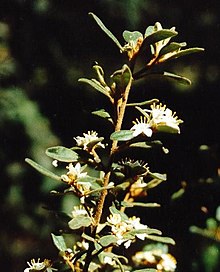Asterolasia beckersii
Asterolasia beckersii, commonly known as Dungowan starbush,[2] is a species of erect shrub in the family Rutaceae and is endemic to a restricted area of New South Wales. It has woolly, star-shaped hairs on its branchlets, egg-shaped to lance-shaped leaves with the narrower end towards the base and covered with star-shaped hairs, and white flowers arranged singly in leaf axils, the back of the petals covered with star-like hairs.
| Dungowan starbush | |
|---|---|
 | |
| Asterolasia beckersii | |
| Scientific classification | |
| Kingdom: | Plantae |
| Clade: | Tracheophytes |
| Clade: | Angiosperms |
| Clade: | Eudicots |
| Clade: | Rosids |
| Order: | Sapindales |
| Family: | Rutaceae |
| Genus: | Asterolasia |
| Species: | A. beckersii |
| Binomial name | |
| Asterolasia beckersii Orme & Duretto[1] | |
| Synonyms[1] | |
|
Asterolasia sp. 'Dungowan Creek' | |
Description
Asterolasia beckersii is an erect shrub that typically grows to a height of 1.5–3.5 m (4 ft 11 in–11 ft 6 in) with its branchlets covered with woolly, fawnish star-shaped hairs. The leaves are egg-shaped to lance-shaped with the narrower end towards the base, 15–40 mm (0.59–1.57 in) long and 5–12 mm (0.20–0.47 in) wide on a petiole about 5 mm (0.20 in) long. The upper surface of the leaves is sparsely hairy and the lower surface covered with greenish to fawnish, woolly, star-shaped hairs. The flowers are arranged singly in leaf axils on a pedicel 2–7 mm (0.079–0.276 in) long. The petals are white, about 6 mm (0.24 in) long and covered on the back with woolly, white star-shaped hairs. Flowering has been observed in October.[2][3][4]
Taxonomy
Asterolasia beckersii was first formally described in 2017 by Andrew Orme and Marco Duretto in the journal Telopea from specimens collected near Dungowan Dam near Tamworth in 2003.[4] The specific (beckersii) honours Doug Beckers for discovering the species.[5]
Distribution and habitat
Dungowan starbush is only known from the type location where in grows in rocky soil along a creekbank.[3]
Conservation status
This plant is listed as "endangered" under the New South Wales Government Biodiversity Conservation Act 2016 . The main threats to the species are its small population size and restricted distribution, road and track maintenance and weed invasion.[2]
References
- "Asterolasia beckersii". Australian Plant Census. Retrieved 25 June 2020.
- "Dungowan starbush - profile". New South Wales Office of Environment and Heritage. Retrieved 25 June 2020.
- "Asterolasia beckersii". Royal Botanic Garden Sydney. Retrieved 25 June 2020.
- Orme, Andrew E.; Duretto, Marco F. (2017). "Asterolasia beckersii (Rutaceae), a new species from the Northern Tablelands, New South Wales". Telopea. 20: 165–169. doi:10.7751/telopea11292.
- "Asterolasia beckersii". APNI. Retrieved 25 June 2020.